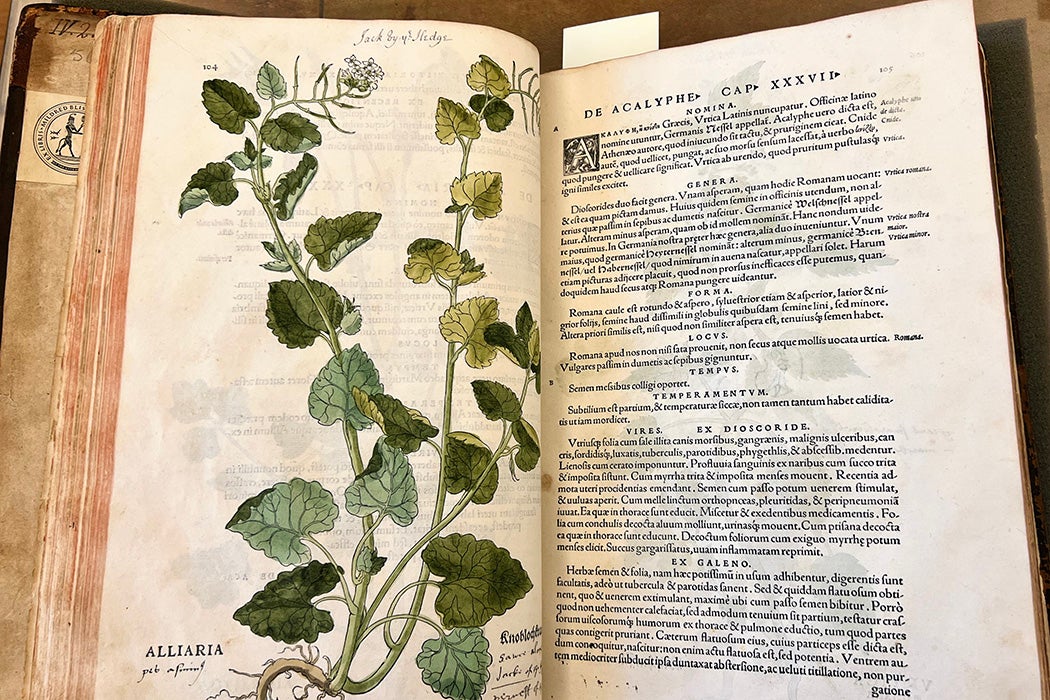In a video posted in the early months of the pandemic, “Cooking with Neighborhood Weeds”, popular TikTok forager Alexis Nikole Nelson (@alexisnikole) shows viewers, whom she notes might be “still afraid to go to the grocery store,” how to make a delicious pesto from a weed “that’s probably growing in your neighborhood.” After explaining how to identify garlic mustard at various life stages and when to harvest it, Nelson notes “your old pal garlic mustard is invasive as heck, please eat all of him!”
For many, the Covid-19 pandemic changed the way they related to plants. Being outdoors offered a safe respite from the pandemic, and those who could not escape crowded urban centers invited nature inside, filling their small apartments with houseplants and tiny gardens. But the pandemic has also increased anxieties over finances, supply chains, and food security. To cope many, like Nelson, turned to a centuries-old cultural practice: foraging.
Foraging is broadly defined as the act of searching for and harvesting wild plants for sustenance. Or, as Nelson quips, “eating plants that don’t belong to me.” Nelson turned to sharing her foraging on social media as a broke, recent college graduate in the middle of a pandemic. But the act of foraging has deeper roots and meaning for Nelson. For many Black and Indigenous Americans, foraging is a means to discover and connect to their literal and symbolic cultural roots.
In Europe, garlic mustard was used as a spice for more than 6,000 years. Native to Europe, Western Asia, and Northwest Africa, garlic mustard was introduced to North America by European colonists. By the 1800s, the plant was cultivated in North American gardens as both a spice and a medicinal plant. Lacking the natural enemies of its native range, garlic mustard soon escaped the confines of the garden and spread across the northeastern and midwestern regions of the US and southeastern Canada. As garlic mustard naturalized, it became a popular plant to forage for impoverished and rural communities, as it was nutritious, delicious, easy to identify, and readily available. This was especially true for enslaved and, later, freed Black communities who relied on foraging as a crucial subsistence strategy. Foraged plants like garlic mustard provided medicine, fought nutritional deprivation, and played a role in maintaining cultural and spiritual traditions.
As Nelson explains in another viral video, responding to a comment chastising her for bring race into a conversation on plants and foraging, “none of our food exists without context,” and that discussions of race are central to the act of foraging. “To say that foraged foods exist without any relation to race or culture is not only disrespectful to the indigenous folks who helped a lot of our ancestors learn the lay of the land, it’s also disrespectful to our ancestors who brought a lot of their plants over, and those plants are now naturalized and we gather them frequently, like your garlic mustards.” Nelson brands herself a Black forager and argues for the cultural and historical significance of this. “Mentioning that I am Black is important because a lot of our Black ancestors had foraging forcibly taken out of their hands by means of more strict trespassing laws in the 1800s.”
Following the Civil War, the practice of foraging was criminalized in many parts of the American South. As Brian Sawers explains, “in 1860, unfenced land across the South was open to the public.” Beginning 1865, however, private property laws were expanded across the US. As Sawers argues, this was in direct connection to emancipation, as white planters attempted to regain control of Black labor. The agricultural and foraging skills cultivated by enslaved communities on plantations meant that “planters needed freedmen, but freedmen did not need planters.” To limit freedmens’ agency outside of the plantation economy, white planters set out to enact a “panoply of laws to control and coerce black labor.”
Central to this was the closing of the range, or open unfenced property. Foraging and hunting were clear threats to the continuation of the plantation economy and culture following emancipation. The simplest way to limit access to open land was to criminalize trespassing on private property, fenced or unfenced. Between 1865 and 1866, Louisiana, Georgia, South Carolina, Alabama, and Florida all passed legislation that made trespassing a misdemeanor statewide. Laws allowing landowners to prohibit foraging and criminalize trespassing spread throughout the US in the late nineteenth and twentieth centuries. Today, these laws are the norm, existing at the federal, state, and local levels.
In this context contemporary foraging takes on even greater significance. While the popularity of foraging is on the rise across demographics, many BIPOC foragers see foraging as a means to reclaim a part of their stolen history and culture.
Today, garlic mustard is viewed as a foreign invader that needs to be eradicated. Most botanical and scientific literature position garlic mustard as allelopathic, a plant that can “produce compounds with bioactive effects that are capable of entering the environment around the plant and persisting long enough to have effects on neighboring organisms.” Garlic mustard also displaces important native vegetation with its prolific growth thanks to its high seed density, and tannin levels that deter deer from eating it. Given the plant’s history and importance in foraging, however, this singular positioning becomes problematic, as it ignores the important new cultural histories acquired by plants like garlic mustard as they naturalized in new environments and became important to different cultures.
While problematizing the notion of an invasive species, Brendon M. H. Larson argues, “we need to reconsider how we relate to them [invasive species] in order to wend a path between the extremes of apathy and antipathy.” Larson suggests seeing invasive species as neither friend nor enemy. Instead, Larson challenges us to see plants like garlic mustard as mirrors, providers, hybrids, tricksters, matrices, transients, founts, and teachers. Reconsidered in this way, perhaps there is a symbiotic relationship to be had between foraging and invasive plants like garlic mustard?
Educating on and encouraging the foraging of plants like garlic mustard would not only help control their growth, but can also improve the health of those in urban centers most affected by poverty and food insecurity. In fact, in a blog post on garlic mustard, Niall Dunne of the Brooklyn Botanic Garden exclaims “we actively encourage you to get out there and harvest with a vengeance… One species we’d like to see culled to oblivion is garlic mustard.”
Weekly Newsletter
Justification for contemporary foraging prohibitions center on unsubstantiated fears over sustainability and assumptions that unfettered foraging leads to over harvesting and the disruption or destruction of important ecosystems. Recent research, however, suggests that there is significant overlap between foragers and conservationists. Through a detailed examination of foraging regulations over time, Baylen J. Linnekin concludes that foraging rules are best established and managed at the local level, especially when it comes to balancing conservation and plant management. Ultimately, Linnekin argues that current regulations are “draconian,” and “by adopting laws that no longer discourage or prohibit the practice of foraging, governments can continue to promote conservation while also better promoting the use and enjoyment of our nation’s unique national, state, and local parklands by a greater and more diverse population of visitors.”
The winding history of garlic mustard troubles the simple positioning of invasive species as wholly bad, and suggests new paths forward in both environmental stewardship and food sovereignty. The Plant Humanities Initiative at Dumbarton Oaks investigates how culture and environment intertwine to define our relationships to plants, as well as how qualities such as “invasive” get assigned to various plants. For more on the precarious relationship between man and “invasive” plants, check out the Plant Humanities Lab.








